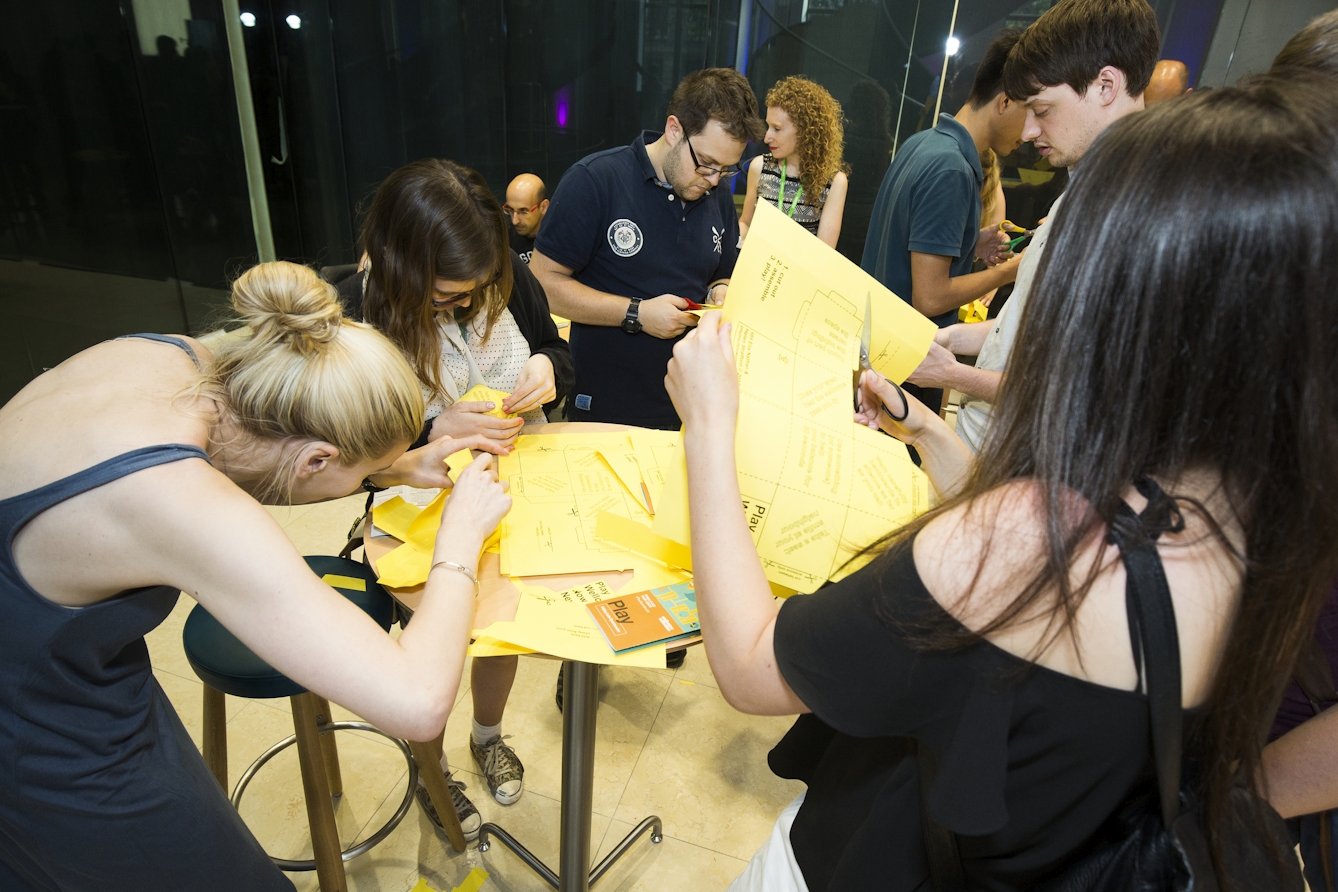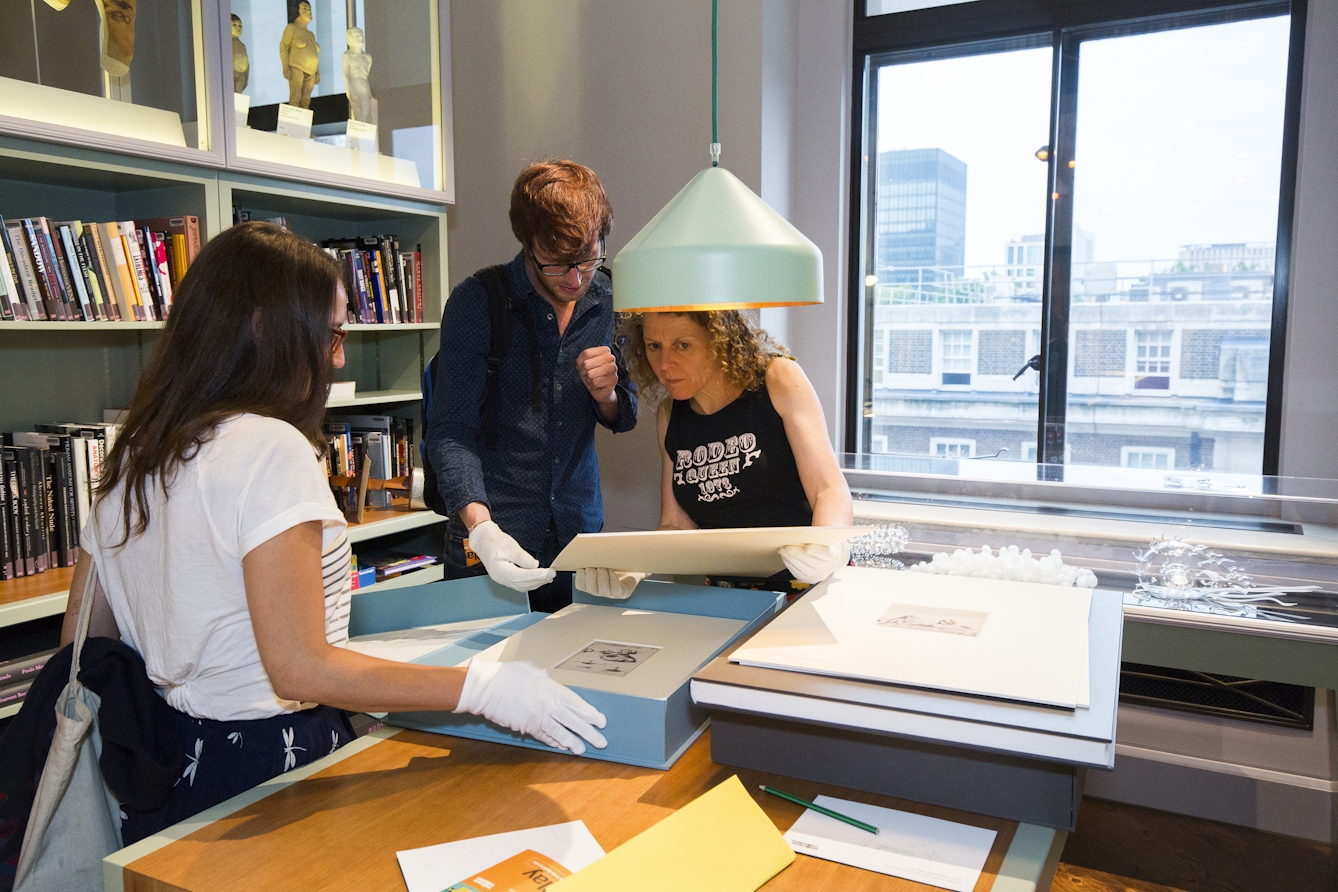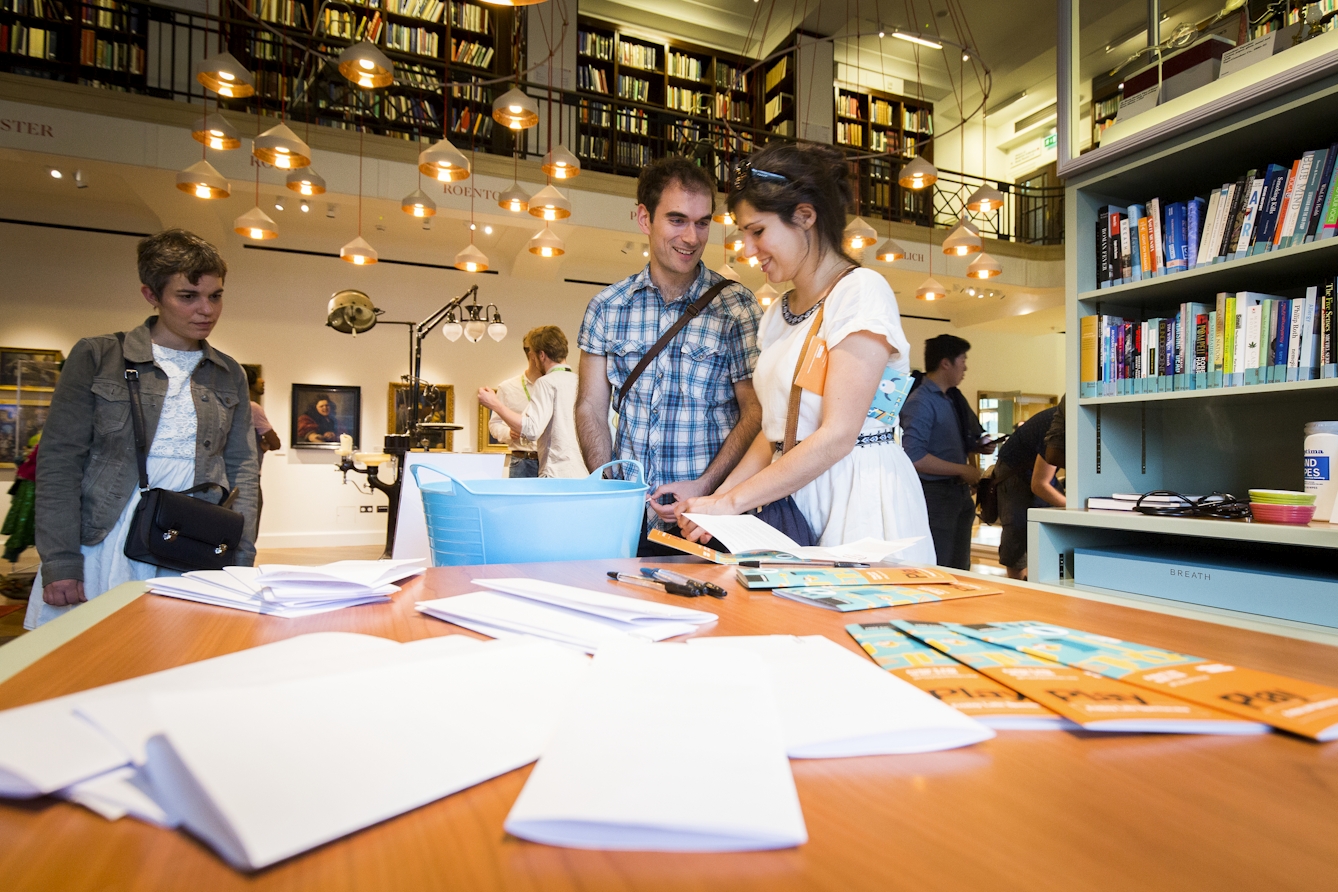People can get more out of a museum visit if they’re allowed to play games. Holly Gramazio argues for museums to embrace those visitors who prefer an unorthodox approach by encouraging self-directed play.
How to play in a museum
Words by Holly Gramazioaverage reading time 9 minutes
- Serial

I’m a game designer who’s interested in history and physical space, so I’ve worked in a lot of museums over the last ten years or so – and it’s definitely been getting easier to play in museums.
In 2008, perhaps you’d find one or two members of staff at a given museum who were interested in play and willing to make arguments for it internally, battling their way through to the point where visitors were allowed to play an actual game. In 2019, people working in museums are way, way more interested in how play can help visitors explore ideas or spaces, engaging them in different ways and creating stories and shared experiences.
Once upon a time games in museums were restricted to one-off events on a Tuesday in mid-September when the Assistant Director of Disapproving of Things was out of town. Now they’re increasingly a core part of what museums offer to their visitors.
So that’s great news for people who like museums and games, right?
Well. Sort of.
If you’ve got a museum lying around somewhere and you want a game to put in it – or if, like me, you’re a game designer and you want a museum to work in – it’s great news. There are a lot of opportunities around, and a lot writing and research and thought that’s aimed right at you. There’s even a whole conference coming up at the V&A. But if you want to actually play, then the bigger picture of games and museums is pretty much irrelevant.

Visitors get stuck into an evening of games at Wellcome Collection.
I’m obviously more interested in games than most people, but I still go to museums based on what’s in them, their themes and cost, and whatever else I happen to be doing that day, not whether there’s a game there I want to play.
And if I do want to play in a museum, but the museum I’m in happens not to have something that suits me, then – well, I’m on my own. That’s fine for me: I’m a game designer, I’ll find something to do. Most recently I tried this game, and it was informative and also depressing:
Woman or Concept
(Adapted from a game by Harry Josephine Giles.)
While you’re walking around a museum or an art gallery, keep an eye out for sculptures of feminine-presenting figures.
When you spot one that interests you, make a guess: is it a woman, or a concept? A real, named person counts as a woman. A representation of sorrow or inspiration or justice or some other abstraction counts as a concept. A mythological or fictional character is worth half a point.
But not everyone has a stack of games at hand, or even a sense of their own right to play in a museum. In fact, this sort of unilateral visitor-initiated play is something that a lot of museums are still resistant to, even museums that are at the forefront of thinking about the benefits of play and games.
This makes sense: looking after a building full of visitors and staff and objects is hard; museums need rules to keep people and objects safe, and games can pull against those rules in sometimes dangerous ways. Museums also want to give visitors a certain sort of experience, and games can mess that up. Look at a simple game like this:
Tour Guide
Each time you see a cabinet, one player examines it first and finds one interesting fact. They then tell their companions that fact – and another that they’ve made up.
When it’s your turn to invent a fact, see if you can get a 50:50 split between people who believe the truth and people who believe the lie.
It’s a diverting enough game, but there’s a downside: you’ll probably remember a few of the lies as true. When humans hear “this cool fact has been debunked”, we often forget the boring “debunked” part and just remember the cool pseudofact. A similar thing happens with games like this, where we remember the story, and don’t necessarily remember whether it turned out to be true.
Once upon a time games in museums were restricted to one-off events on a Tuesday in mid-September when the Assistant Director of Disapproving of Things was out of town.
I once ran a True or False Tour around London, with tour guides who would tell duelling stories at each stop – one truth and one lie. Years later, I went on a different tour led by one of those guides, and he told the group one of the entirely imaginary stories that I’d made up. In the intervening years, he’d forgotten it was a lie, and only remembered the story.

White gloves on and ready to play in the archives.
You should still consider playing Tour Guide; it’s a nice way to structure a chat if you’re in a museum with a couple of friends. But as a visitor, you don’t have a particular responsibility to make sure you don’t misunderstand anything about any given museum – whereas museums do have a responsibility not to mislead you.
Different games can fit in with a museum’s aims to different degrees. Some games for guiding a conversation aren’t at odds with most museums’ implicit aims in the way that Tour Guide is, but also don’t support them:
Polite Society
Choose a question that can be answered using exhibits from the museum you’re exploring.
For example:
You’re going to a party of extremely fashionable artists. You’ve got to make an outfit out of different items of clothing in the historical costumes section of the museum. What do you pick and how do you combine the different items?
Or:
Oh no! A dramatic movie fight is about to break out in the museum! Each of you picks a character – a harried curator, a put-upon security guard, a master criminal, up to you – and takes turns to describe what your contribution to the fight will be.
Or maybe:
The entire museum is a “tag yrself, i’m…” meme. Find the piece of art you feel encapsulates you best.
More explicitly ‘game’-y games, with win conditions and an ongoing score, can fall into this category too:
Shussshhhh
A game for two players.
Walk around a room in a gallery or a museum. You may not communicate with each other.
When you’re ready to leave the room, come back together, and on the count of three – still silent – nod three times or mouth the words or whatever works for you, and point at an object in the room.
If you’re both pointing at the same object, you win.
Do the same thing in the next room, and the next, and the next. How many rounds can you win before you leave the museum?
After you’ve explained the rules of this game, or suggested that you play it, you can not discuss strategy or plan how you will make your decisions; you may not speak again until you finish playing.
If we imagine a scale ranging from “supports the museum’s aims” to “pulls against the museum’s aims”, then most official games sit at the first end, followed by games like these that direct players’ attention in interesting but tangential ways, followed by potentially misleading games like Tour Guide. Theoretically we could go even further along this path, towards games that actively break the rules:
Touch Stuff
Whenever you’re in a museum, touch something. The oldest or most valuable thing you think you can get away with.
If you’re caught and told off by museum staff – ever – then you’re out of the game for the rest of your life.
A friend of mine plays this game; I won’t go to museums with him, and I don’t think he should play it, although I do think it’s funny, and a pretty good piece of game design.
There are less clear-cut ways to break the rules as well. I once worked on a game for a London art gallery, and we were asked to replace dice with spinners – because a dice might roll off under a piece of art, and then someone might try to get it out and accidentally topple a sculpture. As a restriction, this is both really sensible, and really really non-obvious.
Rules and breaking them
So where should you draw the lines for play in a museum? As someone who works for museums, I think it’s wonderful that museums are commissioning explicitly playful work, but I wish more of them also encouraged visitors to engage in self-directed play, exploring this space for playful activities that are currently permitted but not encouraged. Games that people make up on their own might not always be informative about the history of the collection, but having more ways to engage with the space and the objects is valuable in itself.

Finding new ways to play in the Reading Room.
As a visitor, I feel that my responsibility ends at following the museum’s rules; I’m happy to play self-originated games that may subvert the curatorial aims. And the thing that museums can most easily do to help me play like this is to be explicit about what their rules actually are.
Only when museums are clear about exactly what is permitted in their spaces are people able to confidently judge what forms of play are allowed. I’ve worked in museums for a decade and I’m still sometimes not sure what the rules are in a particular space: do these white gloves by the book mean I can touch it if I put them on? If there’s not a no-photography sign, does that mean photography is always okay? Does that mean filming is fine as well?
Obviously no museum is going to put every possible restriction on a sign (“No dice-rolling! If you need a random number use an app instead”). But by communicating positive permissions as well as clear restrictions, museums can allow play-minded visitors to feel confident in their actions, comfortable about what they can and can’t do – and perhaps put them in the mood for a game.
About the author
Holly Gramazio
Holly is a game designer, curator and writer based in London. She works both independently and as half of Matheson Marcault. Her recent projects include the collaborative drawing game Art Deck and the script for the video game Dicey Dungeons. She founded Now Play This, a festival of experimental game design based at Somerset House in London, and is interested in games that get people creating or looking at their environments in new ways.
